Ever noticed how a sudden frost can wipe out your garden overnight? You’ve gotta act fast to protect your plants from unexpected weather changes. Start by checking the forecast daily, especially for temps dipping below 32°F. If a cold snap’s coming, water your plants late afternoon, around 3-4 PM, to insulate roots. Curious about more tricks to safeguard your green space? Stick around for solid tips!
Contents
Sudden Frost Protection
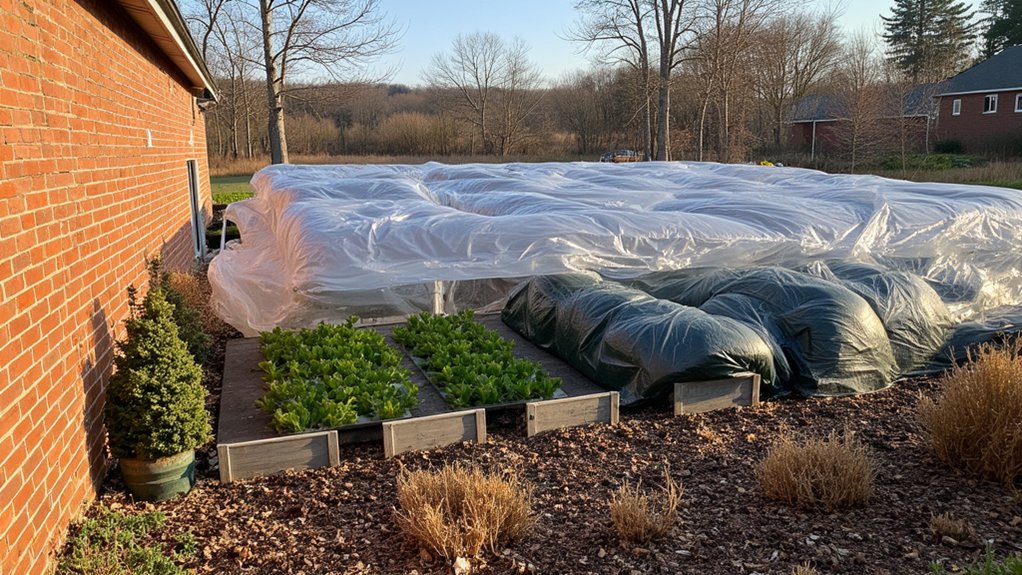
While sudden frost can sneak up on you, don’t worry, you’ve got this with a few quick tricks. First, check the forecast nightly. If temps dip below 32°F, act fast.
Start by watering your plants in the late afternoon, before sunset. Moist soil holds heat better, so give each plant base a good soak, about 1-2 inches deep. This helps insulate roots overnight.
Next, move potted plants indoors, if possible, or cluster them near a south-facing wall. Walls radiate warmth, shielding plants from biting cold. If you can’t move them, wrap pots with burlap for extra insulation.
Finally, mulch around garden beds with 2-3 inches of straw or bark. This traps heat, keeping soil temps steady till morning. You’re set!
Using Protective Row Covers
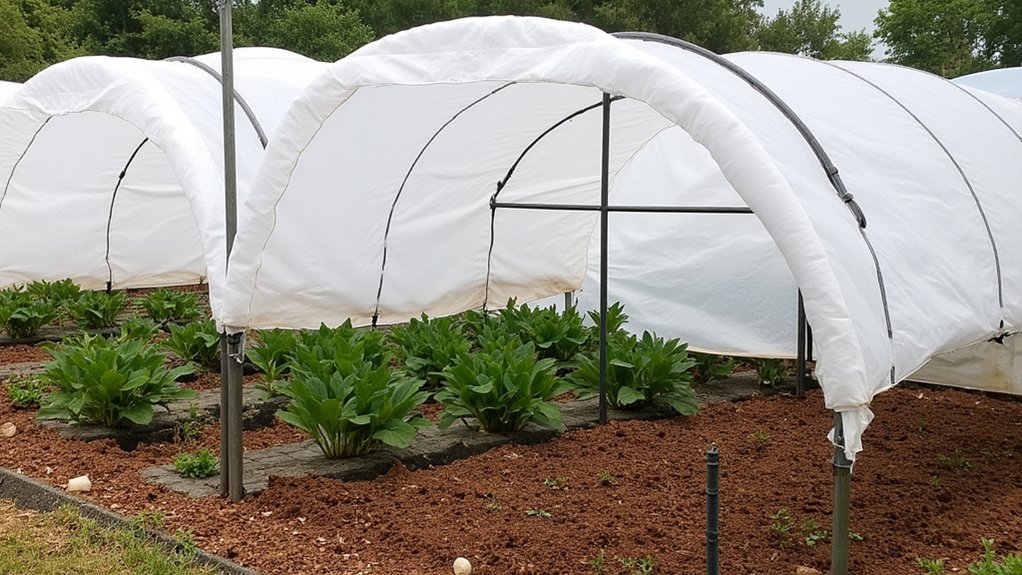
As weather shifts threaten your garden, let’s immerse ourselves in using protective row covers for solid defense. These lightweight fabrics shield your plants from harsh winds, sudden chills, and pesky insects. You’ll find them in garden stores, often in rolls of 5 to 50 feet long.
First, measure your garden beds, then cut the cover to fit, leaving a 6-inch overlap on all sides. Secure it with rocks or garden staples every 2 feet to keep it snug. Make sure it’s loose enough over plants—about 12 inches of slack—to allow growth.
Check weekly for tears or gaps, and adjust as needed. With these covers, you’re giving your garden a fighting chance against unpredictable weather twists.
Mulching for Temperature Control

Hey, let’s plunge into mulching for temperature control, a simple yet powerful way to protect your garden. You’ve gotta try this trick. Mulch acts like a blanket, keeping soil temps steady despite wild weather swings. It’s a game-changer for your plants’ roots.
Start by choosing organic mulch, like straw or wood chips, for best results. Spread a 2- to 3-inch layer around your plants, but don’t pile it against stems, alright? This thickness insulates, holding warmth in cold snaps and cooling soil when it’s scorching. Make sure you apply it after watering, locking in moisture.
Check your mulch every few weeks, topping it up if it thins out. It decomposes over time, so keep an eye on it. Easy, right?
Portable Greenhouse Shelters

Let’s shift gears and talk about portable greenhouse shelters, another smart way to shield your garden from weather surprises. These handy structures, often made of lightweight plastic or fabric, can save your plants from sudden frosts or heat waves. You can set one up in under an hour, no fancy tools needed.
Start by picking a shelter that fits your garden space—many are 6 feet by 8 feet, perfect for small plots. Place it over vulnerable plants, securing the base with stakes or weights to keep it steady. Check the cover daily for tears or moisture buildup, fixing issues pronto. With this setup, you’re giving your garden a quick, reliable defense against unpredictable weather shifts.
Windbreak Barrier Installation
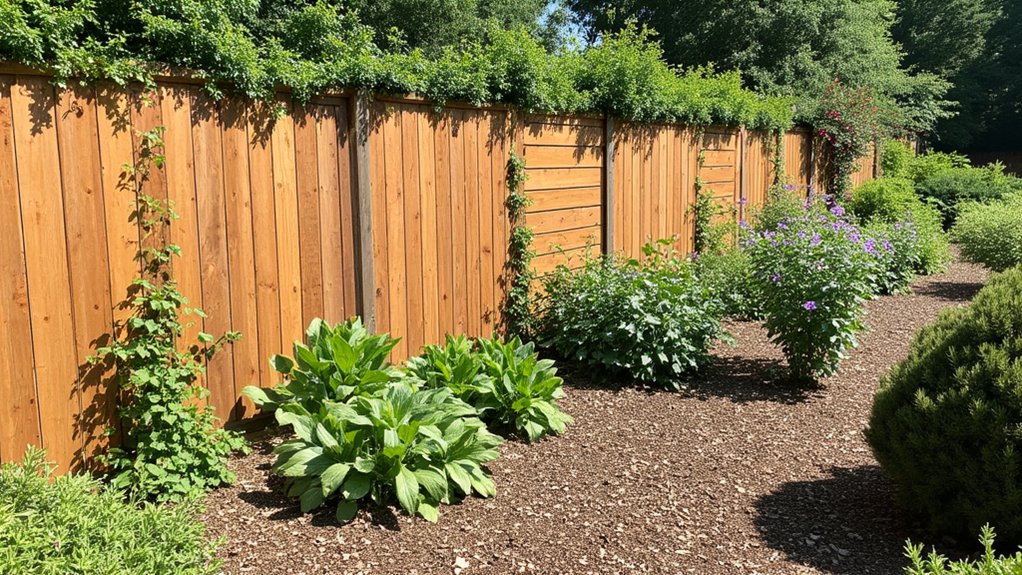
Three solid reasons make windbreak barriers a must for your garden’s defense against harsh winds. First, they cut wind speed, protecting delicate plants from snapping. Second, they reduce soil erosion, keeping your garden intact. Third, they create a microclimate, boosting plant growth.
Now, let’s get to installing one, alright? Grab sturdy materials like wooden panels or dense shrubs, and plan a barrier at least 6 feet tall. Place it on the windward side, about 10-20 feet from your garden, depending on space. Dig post holes 2 feet deep, secure the panels or plant shrubs tightly, and check stability.
It’s straightforward, but takes effort. Finish in a weekend, and you’ve got solid protection. Keep inspecting it monthly for damage, okay?
Watering Before Frost
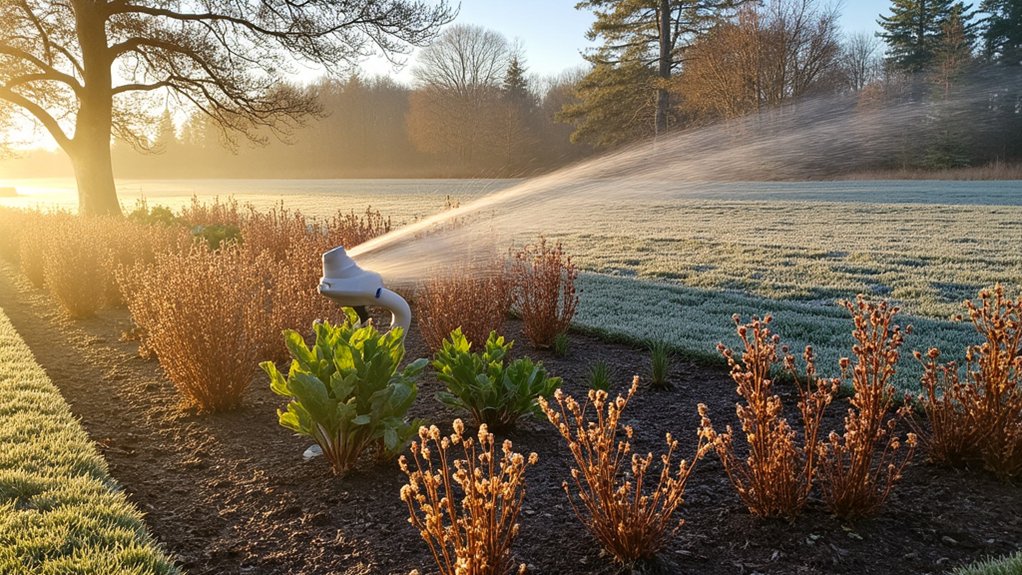
Before the chill of frost creeps in, you’ve gotta prep your garden with a smart watering strategy. Frost can zap moisture from soil, so act fast. Watering now helps plants stay hydrated against the cold.
Get out there 24 to 48 hours before the expected frost, and give your garden a deep soak. Use about 1 inch of water, ensuring it reaches 6 to 8 inches into the soil, especially around roots. This creates a buffer, as moist soil holds heat better than dry dirt.
Don’t overdo it, though; soggy ground can harm plants. Check the forecast, time it right, and water in the morning so excess moisture evaporates by night. Stick to this, and you’re set for frost.
Emergency Plant Cloches

Hey, now that you’ve got your watering down pat before frost hits, it’s time to think about shielding your plants with emergency cloches. These are quick, protective covers to guard against sudden cold snaps. Don’t worry; you can make them with stuff you’ve already got at home.
Grab some clear plastic bottles, like 2-liter soda ones, and cut off the tops. Place the bottom half over small plants, pushing it an inch into the soil for stability. This traps warmth and blocks wind. For larger plants, use gallon jugs or even plastic bins, just make certain there’s airflow to avoid mold.
Check these cloches daily, especially after 24 hours, to prevent overheating. Lift them briefly for ventilation, then secure them again.
Weather Forecast Monitoring
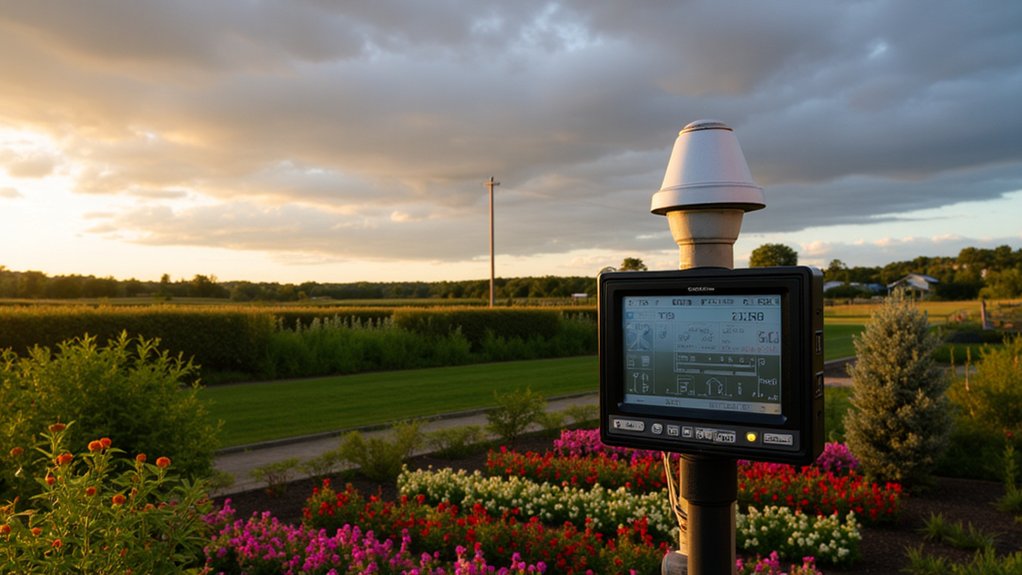
While emergency cloches can save your plants from sudden chills, staying ahead of weather changes is just as essential. You’ve gotta keep tabs on forecasts to protect your garden. Don’t just glance at the weather app; dig deeper.
Check updates twice daily—morning and evening—for the most accurate predictions. Use trusted sources like the National Weather Service or apps with hyper-local data, updating every hour. Set alerts for frost warnings or sudden temperature drops below 32°F, so you’re not caught off guard.
Make a habit of noting patterns over a week. If rain’s coming in 48 hours, prep your soil drainage. Stay proactive, and you’ll dodge most weather surprises. Remember, a quick check can save your blooms from disaster.
Strategic Plant Placement
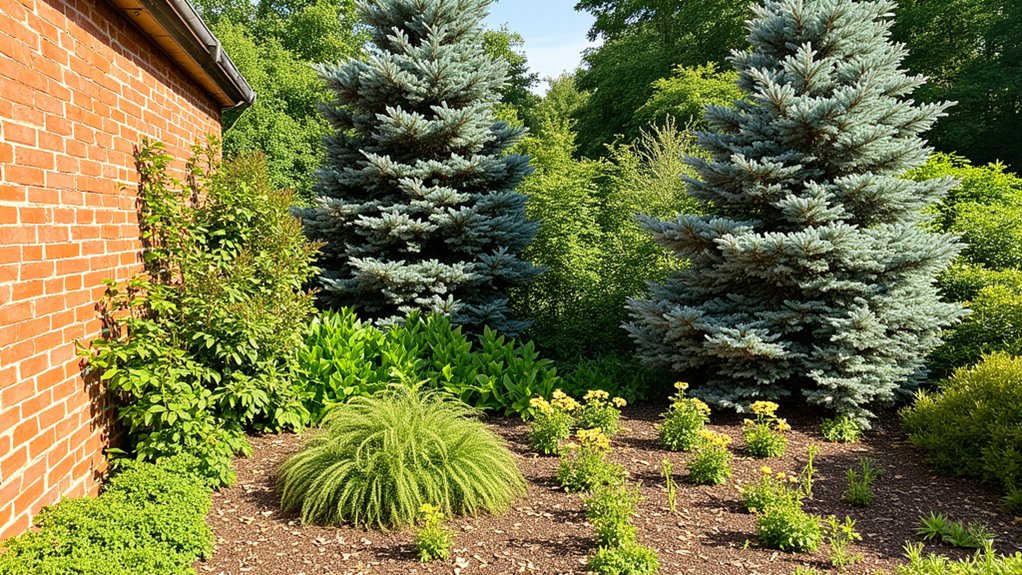
Three key spots in your garden can make or break your plants’ survival against tricky weather. First, place tender plants near a south-facing wall, where they’ll get max warmth, especially in winter. That spot can add 5-10 degrees of heat, shielding them from frost.
Next, use tall trees or fences on the north side to block harsh winds. You’ve gotta position delicate veggies, like lettuce, within 10 feet of this barrier for best protection. It cuts wind speed considerably.
Lastly, avoid low-lying areas for frost-sensitive plants, since cold air pools there. Instead, plant them 2-3 feet higher on slopes, if you’ve got ‘em. Check your garden’s layout today, and shuffle plants around before the next weather surprise hits!
Elevated Plant Beds
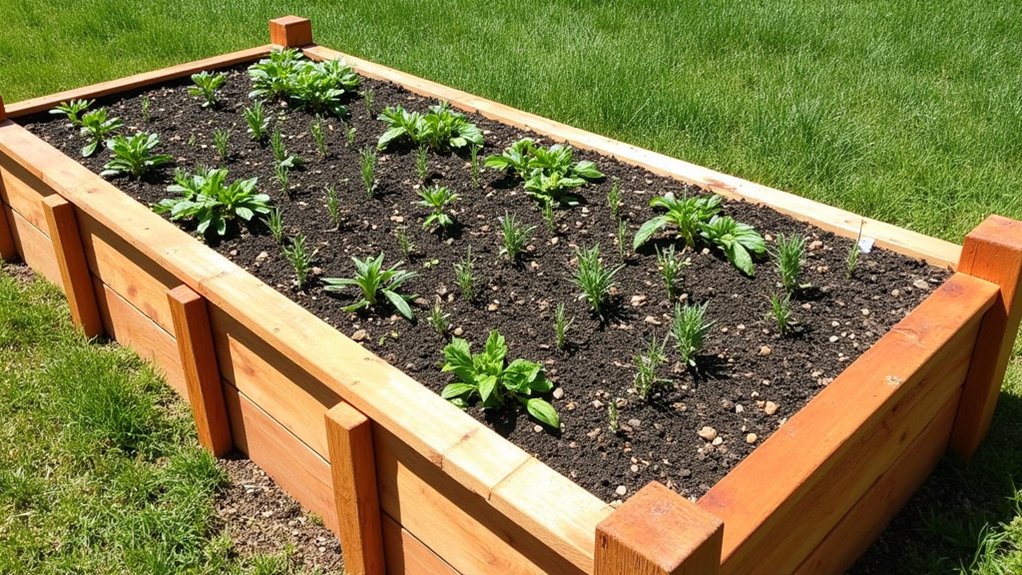
As you tackle weather challenges in your garden, consider building elevated plant beds for better control. They’re a game-changer, trust me. These beds, raised 12-18 inches off the ground, help manage drainage during heavy rains. Plus, they warm up faster in spring, extending your growing season.
Start by picking a spot with good sunlight, at least 6 hours daily. Use untreated cedar or redwood, cut into 4×8-foot frames, for durability. Fill ‘em with a mix of topsoil, compost, and peat moss—about 12 inches deep—for nutrient-rich growing. This setup keeps roots above soggy ground during unexpected downpours.
Check ‘em weekly for soil moisture, especially after storms. Adjust watering as needed, and you’ll dodge most weather woes with ease.
